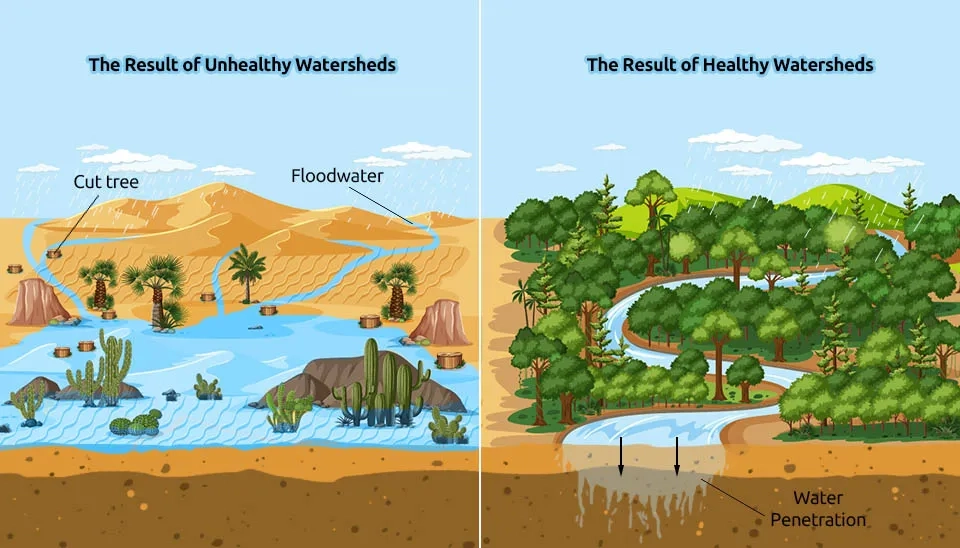
According to the Environmental Protection Agency (EPA), clean and healthy watersheds contribute to over $450 billion in food and fiber production, manufactured goods, and tourism (Mylavarapu et al. 2012). Watersheds are natural environmental and land management units that determine the health of a nation and provide a range of ecosystem services (Flotemersch et al., 2015).
In addition to being essential sources of drinking water, these water bodies also supply water for agriculture, manufacturing, and habitat for a variety of plants and animals (Randhir. 2006). However, it is clear that erosion, runoff, pollution, and other forms of environmental deterioration pose a risk to healthy watersheds. Therefore, it is crucial to safeguard and maintain the quality of watersheds.

Poor management within watersheds has resulted in the impaired functioning of watersheds. Authorities may be able to regulate water distribution and equal access to water resources within a region by proper watershed management principles. Additionally, watershed management helps identify vulnerable regions that need to be protected or restored (Wang et al. 2016). This article will discuss the importance of healthy watershed, challenges and benefits of watershed protection, and how individuals could contribute to better protecting watersheds.

1. Importance of Healthy Watersheds
Anthropological activities, urban development, domestic sewage, agriculture, mining, industrial effluents can enter pathogens, fertilizers and pesticides, nitrogen and phosphorus, and sediments to watersheds and could cause water pollution and damage the natural watershed ecosystem and human health (Jordan et al., 2015; Coffey et al. 2019). Polluted watersheds can threaten the livelihoods and health of the residents who live near the watershed and those who drink the water that runs through it (Forsyth et al., 2004; Merem et al. 2011).

Watersheds without adequate protection inevitably deliver less clean, less reliable water to their downstream dependents. One of the requirements for sustainable development is protecting and maintaining healthy watersheds (Liu et al., 2020). A well-maintained and healthy watershed provides numerous services and benefits to communities and the society, including the supply and purification of fresh water (Postel and Thompson. 2005).

2. Benefits of Healthy Watersheds
watersheds perform a wide variety of valuable services, including the supply and purification of fresh water, the provision of habitat that safeguards fisheries and biological diversity, the sequestering of carbon that helps mitigate climate change, and the support of recreation and tourism. Watersheds are natural assets that deliver a stream of goods and services to society. Our social, environmental, and economic well-being depends on a variety of ecosystem services that healthy watersheds provide (Bunch et al. 2011). Five clearly fundamental functions are exhibited by healthy watersheds (Black, 2007; Postel, 2003):
1. Collect and absorb the water from rainfall, snowmelt, reducing flood damage
2. Storage of various amounts and durations
3. Slow runoff and help recharge groundwater
4. Provides diverse sites and pathways along which vital chemical reactions take place
5. Provides habitat for the flora and fauna that constitute the biological elements of ecosystems
Other advantages of healthy watersheds are:
Nutrient cycling
Carbon storage
Erosion and sedimentation control
Increased biodiversity
Soil formation
Water storage and filtration
Flood control and mitigation
Food, and recreation opportunities
Reduced vulnerability to climate change and prevent natural disasters
reducing water-related disease, and ensuring public health
Addressing poverty, reducing inequities and enhance sustainable livelihoods (Bunch et al., 2011)

With a few million dollars spent on providing healthy watershed, governments can save billions of dollars in infrastructure costs for filtration. For societies facing the challenge of meeting the water supply needs of growing populations, healthy watersheds are natural assets of increasing value. well-managed watersheds and protected areas provide efficient and cost-effective ways of supplying clean water (Postel and Thompson. 2005).

2.1. Economic Advantages of Watershed Protection
Protecting watersheds not only benefits the environment but also brings economic advantages and cost savings to communities (Postel and Thompson. 2005). These include:
Reduced drinking water treatment and infrastructure costs: Natural landscapes filter pollutants and protect water quality, resulting in lower chemical and treatment costs for utilities.
Reduced flood mitigation costs: Floodplains and natural landscapes help minimize flood impacts, reduce the burden on public drainage infrastructure, and enhance groundwater recharge.
Increased revenues and job opportunities: Healthy watersheds provide ample opportunities for recreational activities, contributing to the outdoor recreation industry and supporting local economies.

3. Challenges in Maintaining Healthy Watersheds
To successfully develop and implement an integrated watershed management strategy under various conditions, there needs to be clear goals that consider all elements within the watershed and how they will change temporally, while accounting for the needs and opinions of the public and stakeholders (Wang et al. 2016).
Combined sewer overflows (CSOs), contaminated effluents and runoff , present major challenges to the integrity and sustainability of urban watersheds and cause severe effects on aquatic ecosystems and human health. Water quality and quantity can be altered by irrigation and degraded by runoff of sediment, nutrients, pesticides, along with microbes, and hormones associated with livestock operations, posing risks to drinking water sources. Climate change and extreme events (e.g., major floods and droughts), also threaten watershed integrity and sustainability. Responding to these challenges requires understanding of vulnerabilities, and management strategies to reduce risk (Jordan et al., 2015; Coleman et al., 2011; Vazquez-Prokopec et al., 2010).

4. Healthy Watershed: An Informed Public's Role
Watershed protection involves managing the entire area that drains into a particular water body, such as a lake, river, or stream (Heathcote, 2009). In municipal affairs, water quality control and watershed protection have become increasingly important and contentious. Municipal government is expected to help the general public make informed decisions and encourage their active engagement in providing healthy watersheds.

This approach ensures the preservation of the water body's overall health and functionality. Education and communication strategies conducted by organizations could increase people’s awareness and problem recognition, promoting effective conservation behaviors (Lim et al., 2015). Achieving these goals depends upon the combined efforts of technically trained planners and managers, decision makers, other affected stakeholders, and the general public (Webler and Tuler, 2001). The EPA provides several tips on how to keep watersheds clean and healthy (Roy et al. 2008). Some of these practices include:
Conserving water by taking shorter showers, fixing leaks, and turning off the water when not in use.
Avoiding pouring toxic household chemicals down the drain and instead taking them to hazardous waste centers.
Using plants in yards that require minimal watering, fertilizers, and pesticides.
Using organic or slow-release fertilizers and avoiding over-application.
Utilizing green infrastructure techniques to avoid water runoff.
Properly disposing of used oil or antifreeze, avoiding pouring them into storm drains or streets.

Conclusion
Protecting watersheds would ensure the supply of safe and clean water while maintaining biodiversity, boosting local economies, and improving the wellbeing of people and communities. Each of us can do our part in providing healthy watersheds by preventing pollution, conserving water, and becoming knowledgeable advocates. For the benefit of present and future generations, we should collaborate to safeguard these essential environmental lifelines.
To sum up, proper watershed management is essential for preserving the standard of our water supplies, protecting the ecosystem, and assuring a sustainable future. Together, we can promote sustainable behaviors, increase public awareness, and improve the long-term condition of watersheds by realizing the importance of healthy watersheds and actively protecting them.